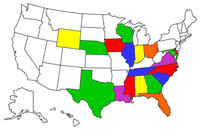
Originally Posted by
Dana

The way I understood it (and I could be wrong, or the rules may have changed) is that when a certificated engine is used in an experimental aircraft, the test flight hours needed are reduced... but because it's a certificated engine, you need an A&P to work on it (the engine), unlike the rest of the aircraft. If you take the data plate off, then it's an no longer a certificated engine, and the flight test time is longer, but anybody can work on it... and then it's forever an uncertificated engine.



 Reply With Quote
Reply With Quote







